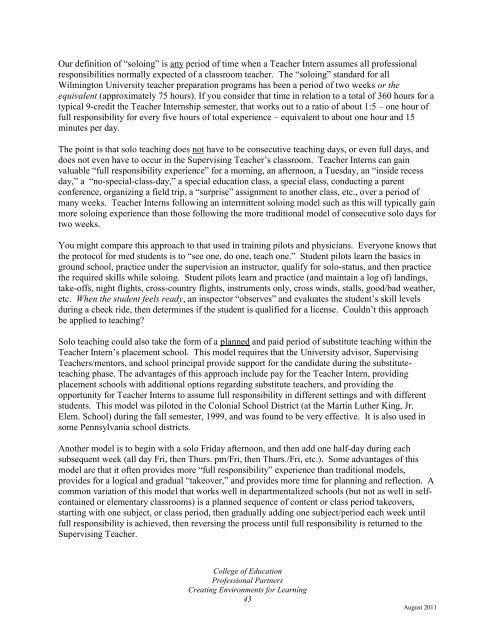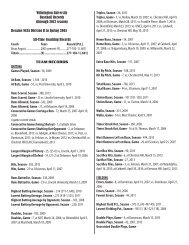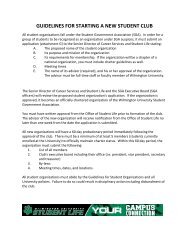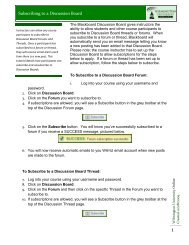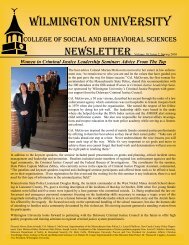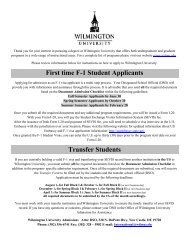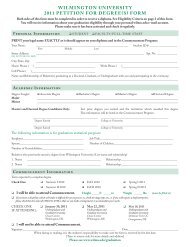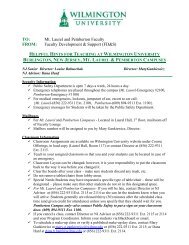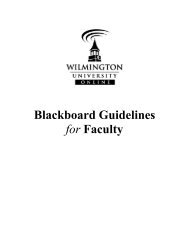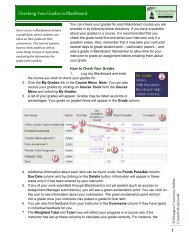handbook for cooperating teachers - Wilmington University
handbook for cooperating teachers - Wilmington University
handbook for cooperating teachers - Wilmington University
Create successful ePaper yourself
Turn your PDF publications into a flip-book with our unique Google optimized e-Paper software.
Our definition of “soloing” is any period of time when a Teacher Intern assumes all professionalresponsibilities normally expected of a classroom teacher. The “soloing” standard <strong>for</strong> all<strong>Wilmington</strong> <strong>University</strong> teacher preparation programs has been a period of two weeks or theequivalent (approximately 75 hours). If you consider that time in relation to a total of 360 hours <strong>for</strong> atypical 9-credit the Teacher Internship semester, that works out to a ratio of about 1:5 – one hour offull responsibility <strong>for</strong> every five hours of total experience – equivalent to about one hour and 15minutes per day.The point is that solo teaching does not have to be consecutive teaching days, or even full days, anddoes not even have to occur in the Supervising Teacher’s classroom. Teacher Interns can gainvaluable “full responsibility experience” <strong>for</strong> a morning, an afternoon, a Tuesday, an “inside recessday,” a “no-special-class-day,” a special education class, a special class, conducting a parentconference, organizing a field trip, a “surprise” assignment to another class, etc., over a period ofmany weeks. Teacher Interns following an intermittent soloing model such as this will typically gainmore soloing experience than those following the more traditional model of consecutive solo days <strong>for</strong>two weeks.You might compare this approach to that used in training pilots and physicians. Everyone knows thatthe protocol <strong>for</strong> med students is to “see one, do one, teach one.” Student pilots learn the basics inground school, practice under the supervision an instructor, qualify <strong>for</strong> solo-status, and then practicethe required skills while soloing. Student pilots learn and practice (and maintain a log of) landings,take-offs, night flights, cross-country flights, instruments only, cross winds, stalls, good/bad weather,etc. When the student feels ready, an inspector “observes” and evaluates the student’s skill levelsduring a check ride, then determines if the student is qualified <strong>for</strong> a license. Couldn’t this approachbe applied to teaching?Solo teaching could also take the <strong>for</strong>m of a planned and paid period of substitute teaching within theTeacher Intern’s placement school. This model requires that the <strong>University</strong> advisor, SupervisingTeachers/mentors, and school principal provide support <strong>for</strong> the candidate during the substituteteachingphase. The advantages of this approach include pay <strong>for</strong> the Teacher Intern, providingplacement schools with additional options regarding substitute <strong>teachers</strong>, and providing theopportunity <strong>for</strong> Teacher Interns to assume full responsibility in different settings and with differentstudents. This model was piloted in the Colonial School District (at the Martin Luther King, Jr.Elem. School) during the fall semester, 1999, and was found to be very effective. It is also used insome Pennsylvania school districts.Another model is to begin with a solo Friday afternoon, and then add one half-day during eachsubsequent week (all day Fri, then Thurs. pm/Fri, then Thurs./Fri, etc.). Some advantages of thismodel are that it often provides more “full responsibility” experience than traditional models,provides <strong>for</strong> a logical and gradual “takeover,” and provides more time <strong>for</strong> planning and reflection. Acommon variation of this model that works well in departmentalized schools (but not as well in selfcontainedor elementary classrooms) is a planned sequence of content or class period takeovers,starting with one subject, or class period, then gradually adding one subject/period each week untilfull responsibility is achieved, then reversing the process until full responsibility is returned to theSupervising Teacher.College of EducationProfessional PartnersCreating Environments <strong>for</strong> Learning43August 2011


